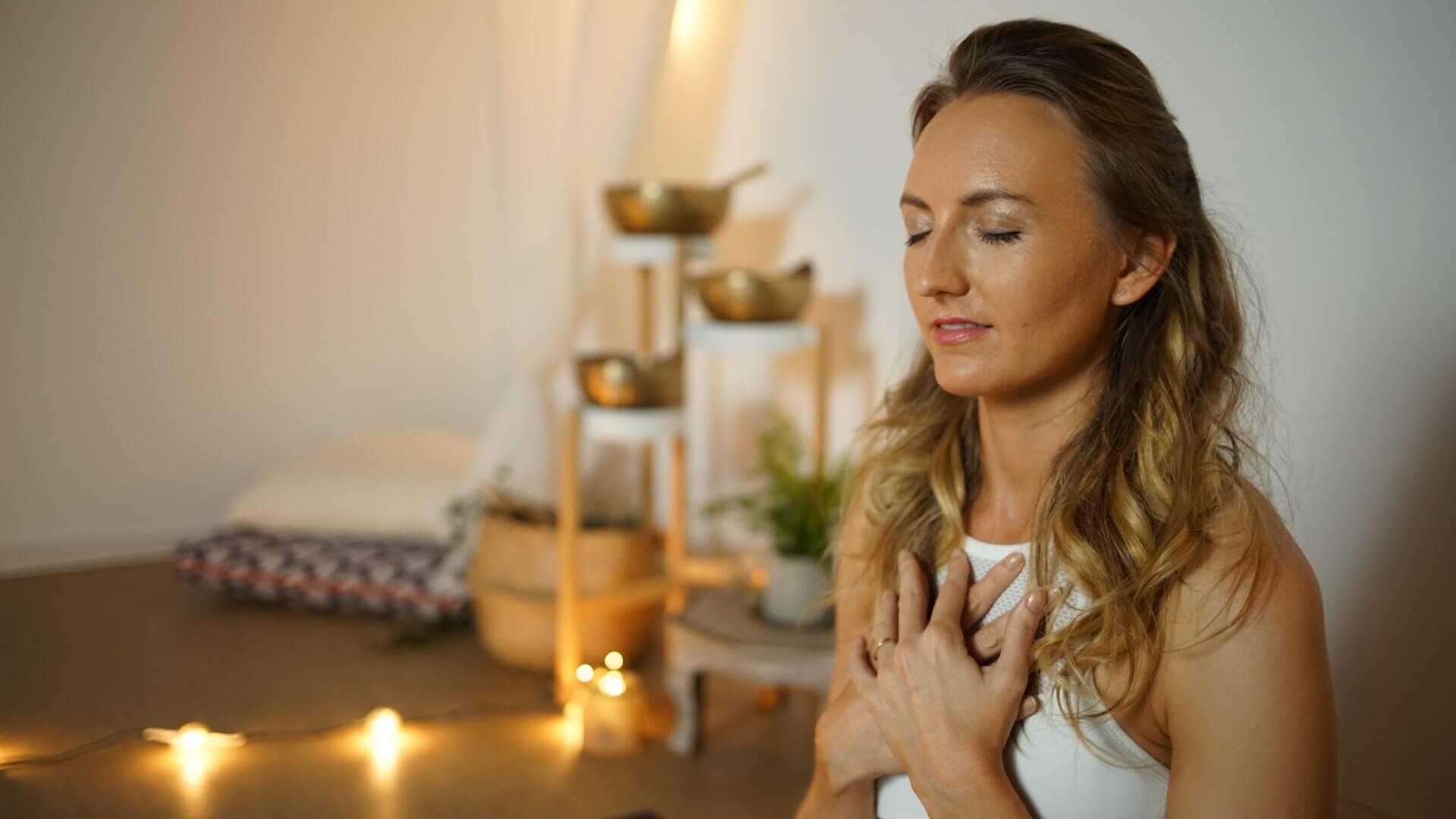
Wanna know a secret? Dhyana, the seventh limb of Yoga, may well be the most important limb yet.
However if, like me, you were a little confused when trying to wrap your head around what dhyana is all about then worry no more because ya girl did the research for you and we are about to break it down in a way that makes sense.
What Does The Word Dhyana Actually Mean?

The word itself comes from the Sanskrit word dhyai, which means “to think of.” In the ancient texts of Buddhism, the word ‘dhyana’ roughly translates to mean ‘concentration of the mind’ or in other words, ‘meditation’.
So you may have heard them interchangeably used and a lot of practitioners not reaaaally explain the difference between the two.
And there’s actually quite a significant difference between them.
If you’ve read up on dharana, the 6th limb of yoga, you’ll know that it is a kind of precursor to a strong meditation practice. It’s a ‘way in’ if you will.
So while meditation is the act of focusing the mind, withdrawing the senses and tapping into pure conscious energy, ‘dhyana’ is the state in which you enter into as a result of that focus and meditation.
You may have heard of ‘tratak’ or candle gazing. It is a form of meditation that helps to channel and focus the mind on one point. Rather than gazing at a flame, many yogis who have experienced dhyana would describe becoming the flame.
It is the difference between doing and being.
Pretty cool right?
How Do I Practice Dhyana?
Honestly? It doesn’t really work like that.
Dhyana is a state of being. It’s a connection to pure consciousness rather than an effort that needs to be made. In fact, it is the absence of effort.
What you can do, however, is practice the 5th and 6th limbs of yoga, pratyahara (withdrawal of the senses), and dharana (one-pointed focus). These are forms of meditation that will exercise the mind into dropping more freely into the state of dhyana. A pure uninhibited state of non-focus and ability to become one with either the object you are using as the focal point of your meditation or simply the body and the breath.
Dhyana is the prelude to the ultimate state of ‘enlightenment’ or the 8th and final limb, Samadhi.
What Are The Benefits Of Dhyana?
With regular practice, deep meditation can be a powerful tool in your overall mental health. Combined with your asana and pranayama practice, which come before dhyana in Patanjali’s Yoga Sutras, dhyana can lead you to absolute bliss.
Think about it.
Ever known a meditator that wasn’t totally zenned out?
That’s cuz mindfulness meditation, or dhyana, is what takes you to your true nature. You know, where all that stillness and awareness lives deep inside of you.
So let’s break down the benefits of this very important part of your yoga practice
1. Samadhi
First and foremost, dhyana serves as a tool to get us to our ultimate yogic goal of true liberation or ‘enlightenment’. Since this is what we’re all gunning for…it’s kind of an important step. Yano?
Everything leading up to dhyana, including asana and pranayama, is meant to help make dhyana as easy as possible.
And in yoga philosophy, you wanna spend a whole lot of time there…
…because that’s where your spiritual liberation, samadhi, awaits you.
2. Improves our memory
Ever walk into a room and feel like your Sims controller has just pressed cancel on whatever task you were doing? Ya, me too. The state of dhyana is supposed to leave us with a clearer mind and a sharper memory.
It’s true. It has been shown to increase the ability to sustain attention as well as working memory.
So it may be a way to avoid walking up the stairs with a goal in mind and coming back down with nothing to show for it. Ya feel me?
3. Improves creativity
Yup! Unleash your creative flair. We only use certain parts of our brains in our daily mundane activities and often neglect to use the creative and expressive parts. The state of dhyana helps to tap into that.
How?
It improves divergent thinking, a.k.a. thinking outside the box.
So not only does it help you become creative in arts and crafts, but it also improves your problem-solving skills because it’s easier to solve problems if you can think creatively about them.
Who knows, you may come out of your meditation practice as the new Picasso, Banksy or Cardi B….
4. Helps you manage anxiety
This is a biggie….obviously. Who doesn’t experience some form of anxiety in our day and age? Being able to enter the state of dhyana helps to soothe and calm the mind. Did you know we have three? When managing anxiety, I find it helpful to remember that the positive mind is only one of three mental bodies according Kundalini yoga philosophy.
Accepting warnings from the negative mind and embracing the calm of the neutral mind can give you perspective on the racing thoughts you might experience when anxious.
In the body, it slows the heart rate, which naturally pushes your body away from fight-or-flight mode (or, an anxious state) and into stillness.
In the mind, mindfulness meditation has been shown to reduce anxiety by regulating self-referential thoughts (all those thoughts you go over again and again and again).
So even if you don’t reach bliss in your meditation session, you’ll definitely be feeling a lot less anxious after you meditate.
5. Makes you more optimistic
It’s true! Sometimes we get stuck in our own contemplation of how things can go wrong and why someone is out to get us. But having a regular meditation practice can make you a more optimistic person.
Incorporating a daily meditation session into your routine can actually make you a more positive person.
And it doesn’t need to be hours a day that you meditate, like an OG yogi. Just 15 to 20 minutes at the end of your yoga practice will do the trick.
So next time your yoga teacher ends the class with a moment of awareness or a guided meditation, be excited. Your perception of the world is about to get a whole lot brighter.
Final Thoughts…
Safe to say I’m sold on the idea of Dhyana…
It’s not an easy feat to get there but we don’t achieve this state by striving to get there. In fact, the more we try, the further away it will become.
Dhyana will come as a natural consequence of consistent practice of the other 6 limbs. It will take time, consistency, and persistence but stick at it and one day it will be the most natural feeling in the world.
Next Steps
- If you’re interested in practical kriya yoga as a way to improve your daily life and relationships, check out my Yoga for Self Mastery course.
- Order my Yoga Life book for a practical guide to creating balance in your life through yoga.
- Check out my YouTube channel and find some yoga classes that you can try out for yourself!
Experience 3 Training Videos from Inside My 200-Hour Online YTT

YOU MIGHT ALSO LIKE
- What is Kriya Yoga? The Philosophy and Practice
- Uddiyana Bandha: Tapping Into Your Deep Core
- 4 Reasons Hasta Bandha Is Essential To Your Yoga Practice
- Vitarka Mudra: What It Is and How Do You Use It?
- Shakti Mudra: What It Is and How Do You Do It?
- Garuda Mudra: What It Is and How Do You Use It?
- Kali Mudra: What It Is and How Do You Do It?
- Shunya Mudra: What It Is and How Do You Do It?
- Varuna Mudra: What It Is and How Do You Use It?
- Vayu Mudra: What It Is and How Do You Use It?
- Samana Vayu: The Energy of Balance & How to Access It
- Apana Vayu: The Energy of Release & Surrender
- Udana Vayu: The Ascending Wind
- Prana Vayu: The Breath of Vitality
- Vyana Vayu: The Energetic Secret to Flow
Learn how to do 11 of the most popular yoga poses correctly. Free video + PDF download.










